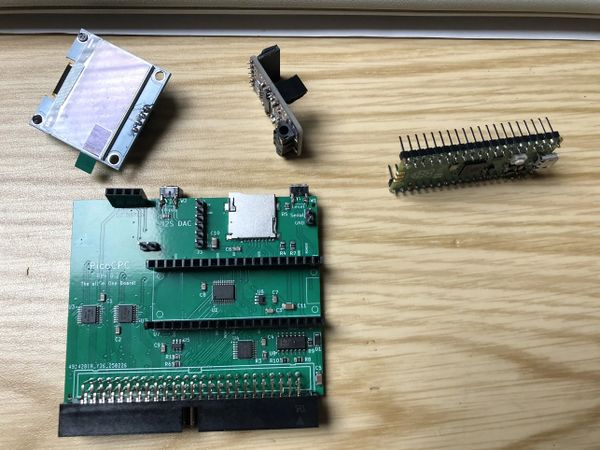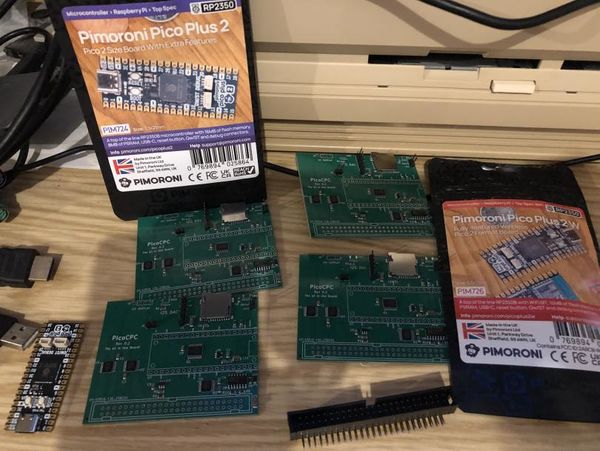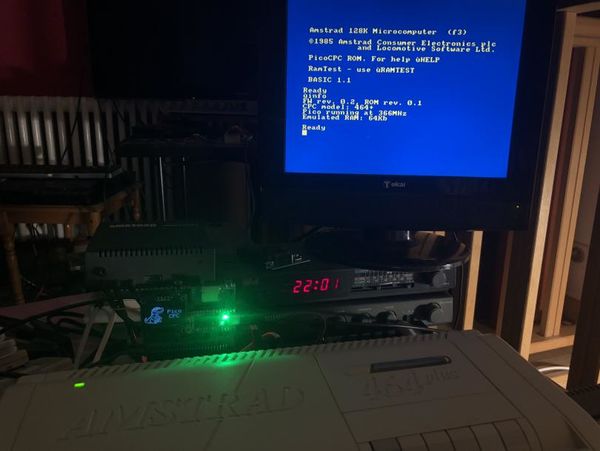Difference between revisions of "PicoCPC"
| (25 intermediate revisions by the same user not shown) | |||
| Line 1: | Line 1: | ||
| − | Rodrik Studio announced its PicoCPC expansion card, which was created with the help of FreddyV (the author of the PicoMEM ISA card for IBM PC). | + | [[Rodrik Studio]] announced its PicoCPC expansion card, which was created with the help of [[FreddyV]] (the author of the [https://github.com/FreddyVRetro/ISA-PicoMEM PicoMEM ISA card for IBM PC]). |
| − | [[File:PicoCPC proto2.jpeg|600px]] | + | [[File:PicoCPC proto2.jpeg|600px]] [[File:Modular PicoCPC.jpg|600px]] |
| − | Final PicoCPC will be with soldered RP2350B. | + | The PicoCPC use a Pico2, connected via multiplexor. This let enough pin to add an I2S DAC, MicroSD and some more control signals. Final PicoCPC will be with soldered RP2350B. |
| − | The | + | The board can decode any I/O port and of course RAM/ROM cycles. As it use a Pico2, its RAM is doubled vs Pico1 and it can access a 8MB PSRAM as well. |
| + | |||
| + | Advantage of this model is on use of CH376 for USB : USB in FAT32&extfs, with nothing to do at the CPC side. | ||
| + | |||
| + | There is no external ROM, so the microntroller access the emulated RAM/ROM and USB/MicroSD at the same time: Direct write from the uSD to the CPC emulated RAM at 3MB/s (For example). | ||
| + | |||
| + | The PicoCPC is clocked at 366Mhz. So it is not as powerful as the [[RSF3]] clocked at 480Mhz. But it is more powerful than the [[M4 Board]] clocked at 168Mhz. [https://www.spinpoint.org/2015/10/23/cortex-m4-board/ Source] | ||
<br> | <br> | ||
| Line 11: | Line 17: | ||
== Features == | == Features == | ||
| − | + | It now has : | |
| − | * ROM ( | + | *ROM Emulation |
| − | + | *RAM Emulation (464/6128), all modes, except C3 mode for now | |
| − | + | *Floppy disk controller emulation, supporting .DSK and even most of the copy protected games. (on 464) | |
| − | * Floppy disk controller ( | + | *Create Floppy "pack" and swap between them with a button |
| − | * | + | *Navigate in the SD and run games from it |
| + | *Setup program helping to do the initial config if there is no config file on the SD (With graphics and music) | ||
| + | *Various commands, to list and load the ROM and Disk images | ||
* Reset button | * Reset button | ||
| − | + | C3 mode to arrive in the next hardware release. And much more for the final hardware release: vocal synthesizer, cpr cartridges, usb, wifi, nfc, ... | |
| + | |||
| + | The Pimoroni hardware is also being evaluated. | ||
| + | |||
| + | [[File:Pimoroni Picocpc.jpg|600px]] | ||
<br> | <br> | ||
| Line 26: | Line 38: | ||
== News == | == News == | ||
| − | + | Here’s the translation into English of the description of the 07/03/2025 video: | |
| − | + | "It’s still far from being finished, but it’s progressing well." | |
| − | + | "What’s still missing:" | |
| − | + | ||
| − | + | ||
| − | + | ||
| − | + | ||
| − | + | ||
| − | + | ||
| − | + | ||
| − | + | ||
| − | * | + | *Loading and unloading ROMs from BASIC |
| + | *Copying files between SD and floppy disk | ||
| + | *Saving files to SD (for now, the Pico can only read and launch) | ||
| + | *Formatting floppy disks | ||
| + | *Displays on the I2C screen during the Wizard | ||
| + | *All the sound part | ||
| + | *All the Wi-Fi part | ||
| + | *All the NFC part | ||
| − | + | "Prototype 2 will require a major change on the I/O side but should normally open up more possibilities, like the C3 memory mode on 464/664, switching to 512KB of extended memory, and sound." | |
| + | |||
| + | "At the moment, I’m aiming for June as a tentative date. Even if the code isn’t finished, the hardware should be." | ||
In the comments of that video, Rodrik said: | In the comments of that video, Rodrik said: | ||
| − | + | ||
| − | + | "When it works on all CPCs, including the Plus models, and the hardware is more or less final, I’m aiming for June." | |
| − | + | ||
| − | + | "The features will evolve; I wrote that in the description. The next big thing will be sound—voice synthesizer—but also a second AY chip and maybe some other quirky stuff like Adlib. Then Wi-Fi and NFC." | |
| − | + | ||
| − | + | "I plan to add Wi-Fi later if possible, and also USB, which is simpler than micro SD for transferring things." | |
| − | + | ||
| − | + | "I can even say it’s very likely that Plus cartridges will be emulated soon." | |
| + | |||
| + | "Wi-Fi is planned for the longer term; the separate Wi-Fi module for Pico2 isn’t available yet." | ||
| + | |||
| + | "There are too many boards, often too expensive, hard to find, and with different features. The idea is that the PicoCPC should cost half the price of a DDI5." | ||
| + | |||
| + | "There will be a case around it to make it look like a peripheral from back in the day." | ||
| + | |||
| + | "The HDD part isn’t great; binaries that load other binaries won’t work. In the end, I could only put a few games on it." | ||
| + | |||
| + | [[File:PicoCPC RSX info.jpg|600px]] | ||
<br> | <br> | ||
== Links == | == Links == | ||
| + | *[[Media:Ch376ds1.pdf|CH376 datasheet]] USB flash drive or SD card controller | ||
* [https://youtu.be/jfOszwaVW7w PicoCPC project presentation - 16/01/2025] | * [https://youtu.be/jfOszwaVW7w PicoCPC project presentation - 16/01/2025] | ||
* [https://youtu.be/ysX8sibAoNk PicoCPC project update - 07/03/2025] | * [https://youtu.be/ysX8sibAoNk PicoCPC project update - 07/03/2025] | ||
| − | * [https://www.cpcwiki.eu/forum/amstrad-cpc-hardware/picocpc/ | + | * [https://www.cpcwiki.eu/forum/amstrad-cpc-hardware/picocpc/ Topic on CPCwiki forum] |
<br> | <br> | ||
[[Category:Peripherals]] [[Category:Hardware]] | [[Category:Peripherals]] [[Category:Hardware]] | ||
| + | [[Category:Music and sound]] | ||
| + | [[Category:Memory expansions]] | ||
| + | [[Category:DATA Storage]] | ||
| + | [[Category:Cartridges]] | ||
Latest revision as of 09:32, 29 March 2025
Rodrik Studio announced its PicoCPC expansion card, which was created with the help of FreddyV (the author of the PicoMEM ISA card for IBM PC).
The PicoCPC use a Pico2, connected via multiplexor. This let enough pin to add an I2S DAC, MicroSD and some more control signals. Final PicoCPC will be with soldered RP2350B.
The board can decode any I/O port and of course RAM/ROM cycles. As it use a Pico2, its RAM is doubled vs Pico1 and it can access a 8MB PSRAM as well.
Advantage of this model is on use of CH376 for USB : USB in FAT32&extfs, with nothing to do at the CPC side.
There is no external ROM, so the microntroller access the emulated RAM/ROM and USB/MicroSD at the same time: Direct write from the uSD to the CPC emulated RAM at 3MB/s (For example).
The PicoCPC is clocked at 366Mhz. So it is not as powerful as the RSF3 clocked at 480Mhz. But it is more powerful than the M4 Board clocked at 168Mhz. Source
Features
It now has :
- ROM Emulation
- RAM Emulation (464/6128), all modes, except C3 mode for now
- Floppy disk controller emulation, supporting .DSK and even most of the copy protected games. (on 464)
- Create Floppy "pack" and swap between them with a button
- Navigate in the SD and run games from it
- Setup program helping to do the initial config if there is no config file on the SD (With graphics and music)
- Various commands, to list and load the ROM and Disk images
- Reset button
C3 mode to arrive in the next hardware release. And much more for the final hardware release: vocal synthesizer, cpr cartridges, usb, wifi, nfc, ...
The Pimoroni hardware is also being evaluated.
News
Here’s the translation into English of the description of the 07/03/2025 video:
"It’s still far from being finished, but it’s progressing well."
"What’s still missing:"
- Loading and unloading ROMs from BASIC
- Copying files between SD and floppy disk
- Saving files to SD (for now, the Pico can only read and launch)
- Formatting floppy disks
- Displays on the I2C screen during the Wizard
- All the sound part
- All the Wi-Fi part
- All the NFC part
"Prototype 2 will require a major change on the I/O side but should normally open up more possibilities, like the C3 memory mode on 464/664, switching to 512KB of extended memory, and sound."
"At the moment, I’m aiming for June as a tentative date. Even if the code isn’t finished, the hardware should be."
In the comments of that video, Rodrik said:
"When it works on all CPCs, including the Plus models, and the hardware is more or less final, I’m aiming for June."
"The features will evolve; I wrote that in the description. The next big thing will be sound—voice synthesizer—but also a second AY chip and maybe some other quirky stuff like Adlib. Then Wi-Fi and NFC."
"I plan to add Wi-Fi later if possible, and also USB, which is simpler than micro SD for transferring things."
"I can even say it’s very likely that Plus cartridges will be emulated soon."
"Wi-Fi is planned for the longer term; the separate Wi-Fi module for Pico2 isn’t available yet."
"There are too many boards, often too expensive, hard to find, and with different features. The idea is that the PicoCPC should cost half the price of a DDI5."
"There will be a case around it to make it look like a peripheral from back in the day."
"The HDD part isn’t great; binaries that load other binaries won’t work. In the end, I could only put a few games on it."
Links
- CH376 datasheet USB flash drive or SD card controller
- PicoCPC project presentation - 16/01/2025
- PicoCPC project update - 07/03/2025
- Topic on CPCwiki forum



